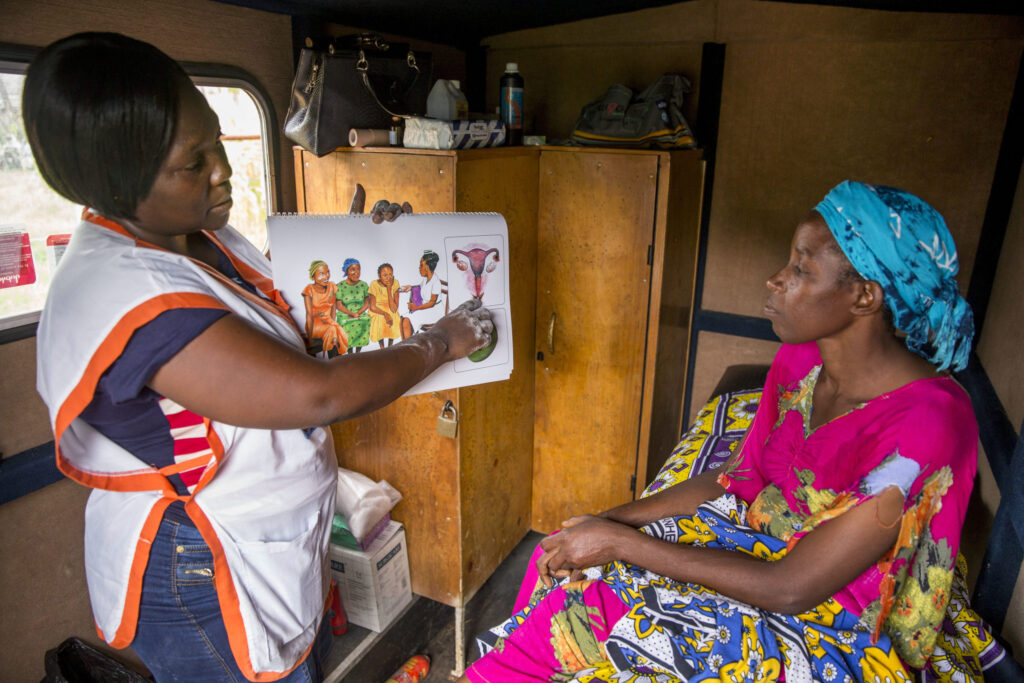Leveraging the Private Sector to Expand Access to Contraception in the Era of Decreasing Donor Funding
The Case of Contraceptive Implants

Family planning (FP) commodities and services in lower- and middle-income countries (LMIC) have historically been heavily subsidized by the donor community. However, donor funding for FP has plateaued and is expected to decline while many countries have yet to meet their FP goals. Countries are looking toward new financing methods and delivery models to create more resilient reproductive health systems, in part through leveraging the private sector’s contributions towards expanding the reach of FP services.
The private sector has been a significant source from which people obtain contraception, with roughly a third of women in LMICs going to private sector outlets particularly for short-term methods, like condoms and pills. Fewer users rely on the private sector for long-term methods such as injectables, implants and IUDs, which are predominantly obtained in the public sector.[1] The private sector consists of both the not-for-profit private sector and the commercial sector, with only the former historically having access to – and the benefit of – subsidized commodities and services. All sectors – the public sector, not-for-profit private sector, and the commercial sector – are key to ensuring that women everywhere have access to the services and care they need. But more effort is needed to support market stewardship so that the private sector is more effectively harnessed to expand access to FP method choice. Ideally, market stewardship is delivered through government mechanisms, but in some instances an intermediary needs to play an interim role.
Contraceptive implants provide an intriguing case study where opportunities exist to better steward and leverage the private sector amidst this broader funding shift. While they have gained significant popularity as an FP method in the public sector, the share of implants obtained in the private sector has remained minimal at 13% in LMICs compared to 86% in the public sector.[2] Over a decade ago, implants were made available at a reduced price to public purchasers through the Implants Access Program (IAP) which aided a nearly three-fold increase in global procurement of implants from 3.9 million in 2012 to 10.6 million in 2021.[3] The public health impact of implants is unquestioned. However, for implants to be sustainably available in the long term, actors throughout the private sector value chain need to be engaged – and appropriately incentivized – to offer implant services. Doing this at scale is particularly challenging given the high upfront unit cost of implants (roughly USD $8.50/unit) and mixed practices and expectations around financing FP supplies and services across LMICs.
The Rationale
As a part of the Expanding Family Planning Choices (EFPC) project, Jhpiego and Impact for Health collaborated in 2022 to understand the barriers to quality provision of contraceptive implant services by the private sector (check out our project landing page and associated blog for more information). In 2023, we collaborated again to build on these findings to develop roadmaps to cultivate the private sector market for implants in two countries: Kenya and Punjab, Pakistan.
Kenya is well-poised to expand its private implant market with an active private sector for FP (33% of all FP users access care through the private medical sector: private pharmacies, hospitals and clinics),[1] a comprehensive FP Total Market Approach (TMA) strategy ready to implement, and widespread population awareness and use of implants (37% of women who use a modern form of FP use implants).[2] However, the private sector has a disproportionately lower share of the implants market (14%) compared to other similar methods (injectables – 37%; and IUCDs – 34%) that also require services from a trained provider. If barriers to private sector expansion are addressed, the implant market could double in size to over 500,000 users within the next few years. Currently, the vast majority of implants are provided by the government to public facilities and select private facilities at no cost and explicitly labeled “not for sale”. But access to free commodities is expected to end as donor funding declines and the Ministry of Health plans to fully fund their FP commodity purchasing by 2025, thus creating pressure to optimize and restrict use of publicly funded goods and, in turn, an opportunity for a true private market for implants.
In Pakistan, despite significant donor investment, the CPR has stagnated around 30% for nearly two decades[3] while unmet need for family planning ranged from 25% to 17% during this time.[4] Traditional methods, condoms and female sterilization account for over 75% of the method mix. More work is needed to diversify method choice and leverage all possible channels to reach women. Only 1% of FP users in Pakistan use implants, 86% of whom obtain it from the public sector (funded by the government) with the remaining 14% obtaining them from the private not-for-profit sector (funded by donors). The commercial private sector, while an active source of healthcare, has not played a significant role in FP provision including implants. Jadelle is the only implant currently in the market, but it is currently registered at a Maximum Retail Price (MRP) that, due to the devaluating PKR, is lower than the purchase price set in USD. However, DKT with support from DKT WomenCare Global is planning to import significant volumes of Levoplant in 2024 and sell to the public sector, private sector (NGO and large hospitals), and small private sector providers, which could be a starting point to build the market.
The Process
Literature review and key informant interviews were conducted to compile country Market Analysis Reports for Kenya and Pakistan. Then, building on these reports, key stakeholders across the value chain in each country were convened to develop Roadmaps charting a pathway for private sector provision of implants in Kenya and Punjab, Pakistan.
The Kenya Roadmap explores several key opportunities:
- Supporting the establishment of a viable supply chain for the private sector through the development of affordable yet differentiated implant products that can provide sufficient margins for all actors in the chain; and the products are valued by consumers. Free provision of commodities to the private sector must stop to allow for natural profit-seeking behaviors to develop amongst private providers.
- Exploring appropriate financing options to offset the anticipated cost increase in the private sector once free public commodities are withdrawn, such as expanding inclusion of FP/implants in health insurance schemes and financing upfront capital for distributors/wholesalers through loan guarantees or guaranteed buyer models.
- Ensuring private providers are sufficiently trained to deliver quality services through improved pre-service training curriculum, and that they report into KHIS regardless of from where they receive commodities.
- Finally, launching the roadmap through Kenya’s TMA Task Force offers a starting point to operationalize the strategy which has struggled to gain traction.
The Punjab, Pakistan Roadmap explores:
- Supporting registration of multiple brands of implant products with the Drug Regulatory Authority Pakistan (DRAP) at a maximum retail price (MRP) that leaves room for profit margin across the value chain in the context of a devaluing rupee while commodities are purchased in USD. DKT has recently registered Levoplant with an MRP much higher than the expected selling point to account for the devaluating rupee, and the same could be done for Jadelle and Implanon NXT.
- Supporting inclusion of multiple brands of implants in Punjab’s Essential Medicine List (EML) to make public purchasing easier, and therefore increase availability and awareness of this otherwise nascent product.
- Temporarily increasing private provider profit margin from offering implants through potential supply side subsidy mechanisms during ramp-up while decreasing the cost to the consumer through vouchers. The temporary subsidies aim to boost profits during the initial low-volume period. If volume increases to a sufficient level, subsidies may be removed, expecting a decrease in profit margin but still providing enough profits to the provider.
- Coordinating demand generation efforts for implants as the product becomes available, leveraging existing community platforms and digital platforms/social media.
- Increasing private provider capacity to provide implants, including mid-level providers such as male family physicians and Lady Health Visitors.
To read the Roadmaps in full, as well as associated products, please click here.
What’s Next?
These Roadmaps offer starting points. In Kenya, the Division of Reproductive Health under the Ministry of Health was engaged in the development and is supportive of the recommendations outlined in the Roadmap. The TMA Task Force is expected to convene and commence the operationalization of these recommendations. Likewise, in Pakistan, both the Department of Health and the Population Welfare Department were part of the roadmap development and support the recommendations, which should be taken forward in provincial FP2030 forums to inform future plans for public and private sectors.
The market assessments and roadmaps have also been shared with funders and partners active globally in the FP product scale-up space, to inform thinking on opportunities to leverage the private sector to expand access to contraception, surfacing several key questions relevant to all FP commodities including:
- How can product subsidy in the public sector serve to de-risk entry and sale of the product for the private sector, without stymying the private market?
- What is the path to reducing subsidies across market functions (i.e., commodity, information, training providers, demand generation) over time to enable all actors to play their role most effectively?
- What are the “right” mechanisms to make products with comparatively high upfront cost (such as implants) more accessible, including but not limited to commodity subsidy?
- Can market segmentation and product differentiation enable varying levels of subsidy within the same market, without distorting it?
- How can multiple sources of financing be leveraged and coordinated to ensure adequate funding for reproductive health supplies while keeping them affordable to the end users? And, how can limited donor investment better target such transformations?
- What market conditions and interventions can stimulate or enable LARC provision in the private sector?
While there are no definitive answers to these questions, progress lies in our collective efforts to invest in and actively share insights and learnings across products and markets – efforts that are increasingly needed to drive meaningful, sustained change in FP access and equity.
[1] Bradley SEK, Shiras T. Where Women Access Contraception in 36 Low- and Middle-Income Countries and Why It Matters. Glob Health Sci Pract. 2022 Jun 29;10(3):e2100525. doi: 10.9745/GHSP-D-21-00525. PMID: 36332074; PMCID: PMC9242616.
[2] Ibid.
[3] Jhpiego and Impact for Health International. 2022. Journey to Scaling Contraceptive Implants.https://www.impactforhealth.com/lessonsforcontraceptiveimplants-journeytoscalingcontraceptiveimplants
[4] Kenya National Bureau of Statistics and ICF international. (2023). Kenya Demographic and Health Survey (2022).https://dhsprogram.com/pubs/pdf/FR380/FR380bis.pdf
[5] Performance Monitoring for Action Kenya. (2021). PMA Kenya (National) Results from Phase 3 panel survey https://www.pmadata.org/sites/default/files/data_product_results/KEP3_National_XS_Results%20Brief_FINAL_0.pdf
[6] Khan AA. Family planning trends and programming in Pakistan. J Pak Med Assoc. 2021 Nov;71(Suppl 7)(11):S3-S11. PMID: 34793423.
[7] National Institute of Population Studies (NIPS) [Pakistan] and ICF. 2019. Pakistan Demographic and Health Survey 2017-18. Islamabad, Pakistan, and Rockville, Maryland, USA: NIPS and ICF. https://dhsprogram.com/pubs/pdf/FR354/FR354.pdf
Love this article and want to bookmark it for easy access later?




